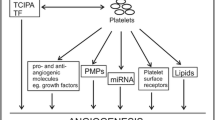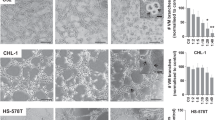Abstract
Recent studies indicate that chemotherapy is a cause for thrombosis in breast cancer patients. We performed experiments to determine whether the enhanced thrombosis was due, in part, to an effect of chemotherapy on endothelial cell reactivity. Heparinized blood samples were obtained from stage II breast cancer patients receiving monthly adjuvant chemotherapy consisting of cyclophosphamide, epirubicin and 5-fluorouracil. Cultured human endothelial cells were incubated with the plasmas for 2 h, and then the reactivity of the endothelial cells to normal donor platelets was determined isotopically. Endothelial cell reactivity was increased when the endothelial cells were incubated with the post-chemotherapy plasmas. The plasma effect persisted after the chemotherapy drugs were cleared from the circulation, but this plasma effect was abolished when the plasmas were heat-inactivated. Furthermore, the increase in endothelial cell reactivity correlated with the level of interleukin-1 present in the post-chemotherapy plasmas. Finally, the increased endothelial cell reactivity was inhibited by the GRGDS peptide, or by an antibody to the endothelial cell vitronectin receptor. These observations suggest that chemotherapeutic drugs alter endothelial cell reactivity to platelets by inducing the release of interleukin-1 which, in turn, facilitates adhesion molecule expression on the endothelial cell surface. If so, these observations provide a possible explanation for one mechanism which may contribute to the thrombogenic effect seen in breast cancer patients undergoing chemotherapy.
Similar content being viewed by others
References
Buchanan, M. R., Vazquez, M. J., and Gimbrone, M. A. Jr, 1983, Arachidonic acid metabolism and the adhesion of human polymorphonuclear leukocytes to cultured vascular endothelial cells. Blood, 62, 889–893.
Cersosimo, R. J., and Hong, W. K., 1986, Epirubicin: a review of the pharmacology, clinical activity and adverse effects of an adriamycin analogue. Journal of Clinical Oncology, 4, 425–439.
Chabner, B. A., and Myers, C. E., 1985, Clinical pharmacology of cancer chemotherapy. Cancer: Principles and Practice of Oncology, edited by V. T. De Vita Jr, S. Hellman and S. A. Rosenberg (Philadelphia: Lippincott), pp. 296–297.
Cheresh, D. A., Smith, J. W., Cooper, H. M., and Duarantea, V., 1989, A novel vitronectin receptor integrin (αvβx) is responsible for distinct adhesive properties of carcinoma cells. Cell, 57, 59–69.
Dejana, E., Bertocchi, F., Bortolami, M. C., Regonesi, A., Tonta, A., Breviaro, F., and Giavazzi, R., 1988, Interleukin-1 promotes tumor cell adhesion to cultured human endothelial cell. Journal of Clinical Investigation, 82, 1466–1470.
Doll, D. C., Ringenberg, Q. S., and Yarbro, J. W., 1986, Vascular toxicity associated with antineoplastic agents. Journal of Clinical Oncology, 4, 1405–17.
Fuma, F. D., Rogers, H. J., and Trouncer, J. R., 1979, Pharmacokinetics of cyclophosphamide and alkylating activity in man after intravenous and oral administration. British Journal of Clinical Pharmacology, 8, 209–217.
Godfrey, K., 1985, Statistics in practice: comparing the means of several groups. New England Journal of Medicine, 313, 1450–1456.
Goodnough, C. T., Saito, H., Manni, A., Jones, P. K., and Pearson, O. H., 1984, Increased incidence of thromboembolism in stage IV breast cancer patients treated with a five drug chemotherapy regimen. Cancer, 54, 1264–1268.
Healey, B., Tormey, D. C., Gray, R., Taylor, S., and Cummings, F., 1987, Arterial and venous thrombotic events in ECOG adjuvant breast cancer trials. Proceedings of the American Society of Clinical Oncology, 6, 208.
Hendrick, A., and Subramanian, V. P., 1980, Tamoxifen and thromboembolism. Journal of the American Medical Association, 243, 514–515.
Jaffe, E. A., Nachman, R. L., Becker, D. G., and Minick, C. R., 1973, Culture of human endothelial cells derived from the umbilical veins. Journal of Clinical Investigation, 52, 2745–2756.
Jordan, V. C., Fritz, N. F., and Tormey, D. C., 1987, Long-term adjuvant therapy with tamoxifen: effects on sex hormone binding globulin and antithrombin III. Cancer Research, 47, 4517–4519.
Lauri, D., Bertomeu, M. C., Orr, F. W., Bastida, E., Sauder, D., and Buchanan, M. R., 1990, Interleukin-1 increases tumor cell adhesion through an RGD dependent mechanism: in vitro and in vivo studies. Clinical and Experimental Metastasis, 8, 27–32.
Levine, M. N., Gent, M., Hirsh, J., Arnold, A., Goodyear, M. D., Hryniuk, W., and DePauw, S., 1988, The thrombogenic effect of anticancer drug therapy in women with stage II breast cancer. New England Journal of Medicine, 318, 404–7.
Licciardello, J. T. W., Moake, J. L., Rudy, C. K., Karp, D. D., and Hong, W. K., 1985, Elevated plasma von Willebrand factor levels and arterial occlusive complications associated with cisplastin-based chemotherapy. Oncology, 42, 296–300.
Lipton, A., Harvey, H. A., and Hamilton, R. W., 1984, Venous thrombosis as a side effect of tamoxifen treatment. Cancer Treatment Reports, 68, 887–9.
Nevasaari, K., Heikkinen, M., and Taskienen, P. J., 1978, Tamoxifen and thrombosis. Lancet, 2, 946–947.
Nicolson, G. L., and Custead, S. E., 1985, Effects of chemotherapeutic drugs on platelet and metastatic tumor cell-endothelial cell interactions as a model for assessing vascular endothelial integrity. Cancer Research, 45, 331–336.
Pritchard, K. I., Pater, J., Paul, N., Paterson, A. H. J., and Fine, S., 1983, Thromboembolic complications related to chemotherapy in a National Cancer Institute of Canada randomized trial of tamoxifen versus tamoxifen plus chemotherapy in postmenopausal women with axillary node positive receptor positive breast cancer. Proceedings ASCO, 8, 25.
Rice, G. E., Gimbrone, M. A., Jr, and Bevilacqua, M. P., 1988, Tumor cell endothelial cell interactions. Increased adhesion of human melanoma cells to activated vascular endothelium. American Journal of Pathology, 133, 204–210.
Rogers II, J. S., Murgo, A. J., Fontana, J. A., and Raich, P. C., 1988, Chemotherapy for breast cancer decreases plasma protein C and protein S. Journal of Clinical Oncology, 6, 276–281.
Ruiz, M. A., Marugan, I., Estelles, P., Espana, F., Aznar, J., and Garcia-Conde, J., 1987, The influence of chemotherapy on the plasmatic coagulation and fibrinolytic system in lung cancer patients. Thrombosis and Haemostasis, 58, 110 (abstr).
Ruoslahti, E., and Pierschbacher, M. D., 1986, Arg-Gly-Asp: versatile cell recognition signal. Cell, 44, 517–518.
Sauder, D. N., Carter, C. S., Katz, S. I., and Oppenheim, J. J., 1982, Epidermal cell production of thymocyte activating factor (ETAF), Journal of Investigative Dermatology, 17, 34–39.
Wall, J. G., Weiss, R. B. Norton, L., Perloff, M., Rice, M. A., Korzun, A. H., and Wood, W. C., 1989, Arterial thrombosis associated with adjuvant chemotherapy for breast carcinoma: a Cancer and Leukemia Group B study. American Journal of Medicine, 87, 501–504.
Warner, S. J. C., Auger, K. R., and Libby, P., 1987, Interleukin-1 induces interleukin-1: II. Recombinant human interleukin-1 induces interleukin-1 production by adult human vascular endothelial cells. Journal of Immunology, 139, 1911–1917.
Weiss, R. B., Tormey, D. C., Holland, J. F., and Weinberg, V. E., 1981, Venous thrombosis during multimodal treatment of primary breast carcinoma. Cancer Treatment Reports, 65, 677–679.
Winer, B. S., 1971, Statistical Principles and Experimental Design (New York: McGraw Hill), pp. 191–196.
Author information
Authors and Affiliations
Rights and permissions
About this article
Cite this article
Bertomeu, M.C., Gallo, S., Lauri, D. et al. Chemotherapy enhances endothelial cell reactivity to platelets. Clin Exp Metast 8, 511–518 (1990). https://doi.org/10.1007/BF00135874
Received:
Accepted:
Issue Date:
DOI: https://doi.org/10.1007/BF00135874




